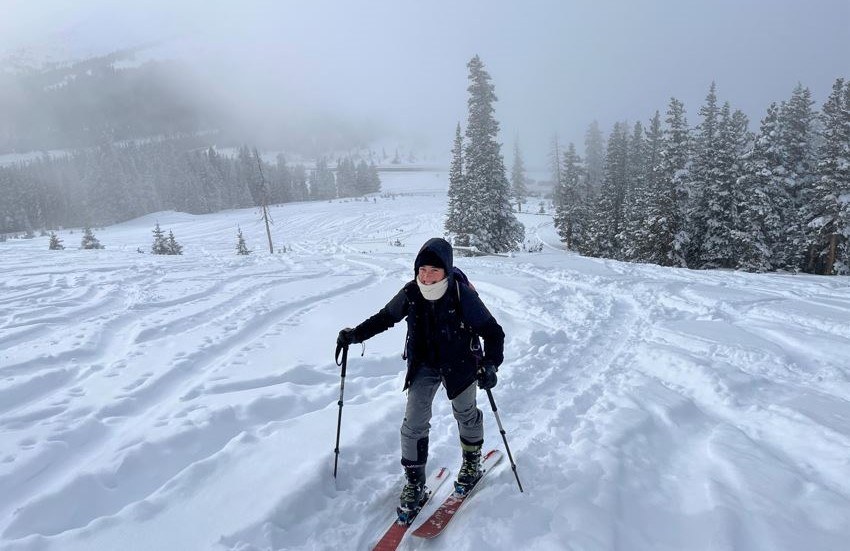
I’ve always been a physically active person. I love hiking and camping, and can withstand extreme heat and cold rain. Snow sports, on the other hand, were an entirely different game. I had friends who skied, but often tuned out when they talked about skiing because I didn’t understand the jargon.
I’m from Los Angeles, and though I spent five years living in New York and New Hampshire, I avoided being outside in weather below 32 degrees whenever possible. If I had to go somewhere in the snow, I hustled as quickly as I could, took public transportation, or got rides from friends. I never chose to spend extended periods of time in the freezing cold, but the possibilities of winter opened when my partner Ben, an avid skier and snowboarder since childhood, became determined to get me on the slopes.
Gearing up for groomed slopes
The first step to getting me outside was acquiring the right gear. Ben and I sought gear optimized for versatility so I could learn to ski both at resorts and in the backcountry. I felt like a doll at first when Ben zipped me up, adjusted my bindings, and tightened my straps. It was eye-opening to be introduced to the world of skiing in my mid-thirties, a world I hadn’t scratched the surface of before.
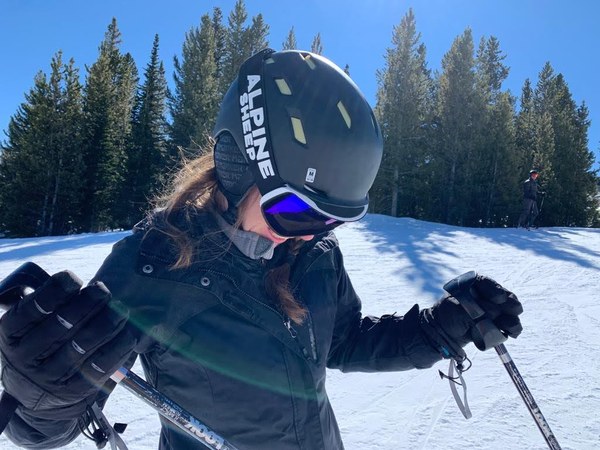 learning to ski at the Winter Park resort.
learning to ski at the Winter Park resort.
My first time on skis was at Winter Park on the free bunny hill called Galloping Goose. It dumped snow most of the time, as if we were inside a snow globe. Throughout the day, I learned how to fasten my boot buckles, get on and off the lift, and keep my skis parallel and my weight forward as I let gravity do the work. It was humbling to learn something new at age 33, and my movements were stilted the first few laps, but by the end of the day, I felt like I was flying down that little bunny hill.
We returned to the resort the next day with friends. I tried skiing greens and blues, and my friends gave useful guidance. I remember feeling intimidated by other people whizzing past on skis and snowboards, and my stomach dropped whenever I hit what I considered a steep section. To get down the mountain, I made wide and meandering turns. When I got nervous I was going too fast, I fell to brake. My friend Claire advised me to “make a plan”: to take time at the top of a run to look ahead, decide where I want to make my turns, and then go with confidence.
We visited Winter Park again with friends the following month. I took a ski class and learned more about technique. The instructor told me to keep the pressure in the middle of my boot and my torso pointed down the mountain at all times, even when my skis were turned. I left class feeling confident and able to appreciate the adrenaline rush of skiing. I loved feeling cold air blow past my cheeks as I carved my skis down the mountainside, shifting my weight from one ski to another to make controlled turns. At the end of the day, I relished the wholesome state of exhaustion, the well-deserved glass of red wine, and hot shower. I realized while we cooked together and sat around the dinner table talking and laughing that skiing is both a social and highly personal endeavor.
By the end of the season, cruising blues at the resorts felt natural. We traveled to Winter Park in May, and I realized how amazing spring skiing is: fewer people, sunshine, blue skies. We rode lines from the top of the mountain down a big, open bowl then through sparce trees that required tighter turns than usual. I had a huge smile on my face the whole time.
Entering the backcountry
When it was time to introduce me to the backcountry, Ben and I drove to Kratka Ridge in the San Gabriel Mountains near where we live in Los Angeles, pit stopping at REI to buy a probe, shovel, and beacon for safety.
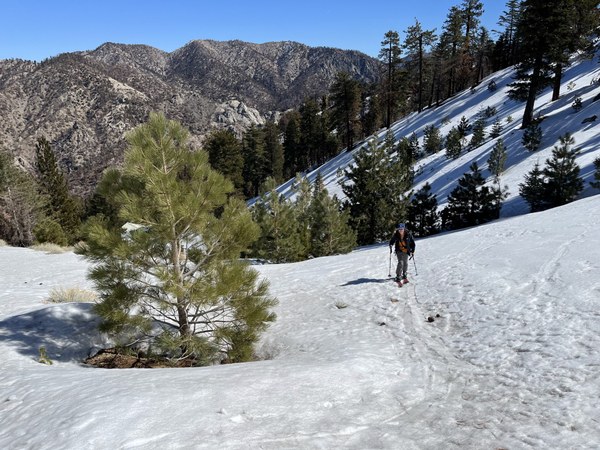 learning to backcountry ski at Kratka in the San Gabriel Mountains.
learning to backcountry ski at Kratka in the San Gabriel Mountains.
I found skiing downhill in the backcountry terrifying. There was no clear path down, the mountain was covered in treacherous trees and boulders, and I imagined falling off the side and tumbling to my death. I clenched my arms and legs so tight that the next day, I was excruciatingly sore in muscles I didn’t even know existed. I forgot everything I learned about skiing at the resort, unable to use any of the techniques I’d practiced and toppling at every turn. I was used to having a warmup run, but you usually only get one run in the backcountry since it’s so much work to hike to the top.
I tried to stay positive, but I was disappointed. Being in the backcountry is what Ben loves most about snowboarding, and I knew he was excited to share this with me. I didn’t want to let him down or come across as physically inept. I wanted to improve, so we went backcountry skiing again.
After Kratka, Ben took me backcountry skiing on Berthoud Pass in Colorado. It was magical. The terrain was at a lower angle than Kratka, and I had more resort skiing practice under my belt. I felt like I was flying! I was stoked.
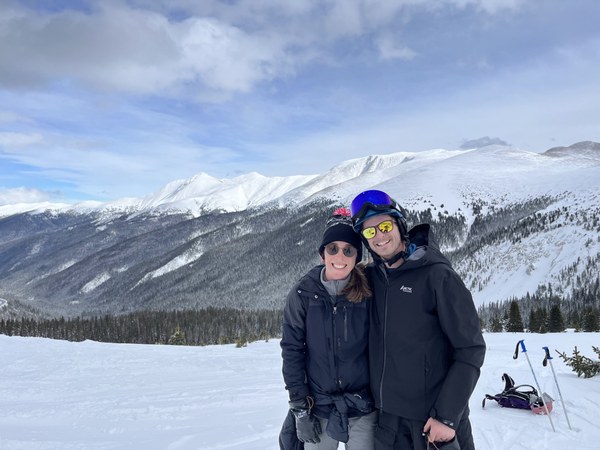 Erica and Ben backcountry skiing at Berthoud Pass in Colorado.
Erica and Ben backcountry skiing at Berthoud Pass in Colorado.
Being patient with progression
On a backcountry ski trip to Elderberry Canyon on Mount Tom, I had a complete meltdown. Even the uphill was hard. My skins kept slipping: I took one step forward and slid two steps back. I tried taking off my skis and walking in my boots, but I just post-holed in the deep snow. When we finally made it to the top, I turned around and my heart sank when I looked back at where I needed to go. There’s no way, I thought. My confidence in my physical capabilities was completely lost. What I did down the mountain could hardly be called “skiing.” It was more like falling. I felt so awkward and incompetent.
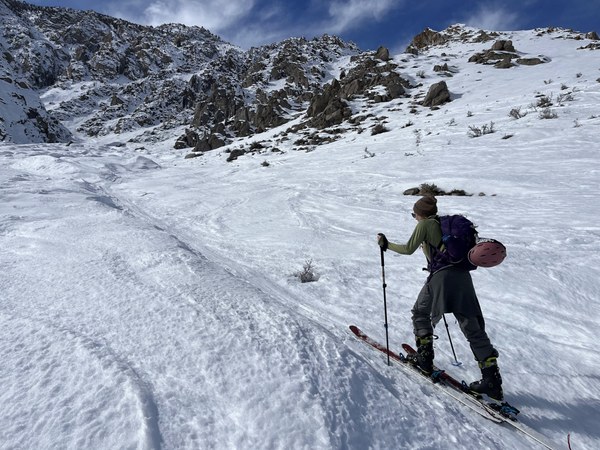 backcountry skiing in Elderberry Canyon on Mount Tom in the Sierra Nevada.
backcountry skiing in Elderberry Canyon on Mount Tom in the Sierra Nevada.
Back at the car, I accepted that progress isn’t linear: I wasn’t necessarily going to improve every time I went backcountry skiing. I had a hard time on Kratka, a great time at Berthoud Pass, and a terrible time on Mount Tom. I needed to adjust my expectation that I would immediately become an expert backcountry skier and develop a growth mindset. I had to see my struggles and mistakes as steppingstones on the way to learning. I wanted to be able to laugh at myself rather than consider myself a failure for not being able to backcountry ski like a pro after three attempts. Ben has such faith in my physical abilities. He believes that if he can do something, I can as well. His confidence in me inspires me to have confidence in myself.
A family love for skiing
Two years after Ben taught me to ski, I’m pregnant with our first child. I ride blues at the resort, confident I won’t fall and injure myself or the baby. Winter Park feels like my ski home: I’m comfortable navigating the trail maps and familiar with the chair lifts to my favorite blue runs.
Backcountry skiing is a different story. I don’t feel confident enough to tour while pregnant, and I’m nervous but eager to continue learning next season. Once our baby comes, Ben wants to get her out in the snow and teach her to ski as soon as possible. After I give birth, I want to keep learning: to ride backcountry, bumps, trees, blacks. There’s a whole beautiful snow filled world that my husband and daughter are going to love.
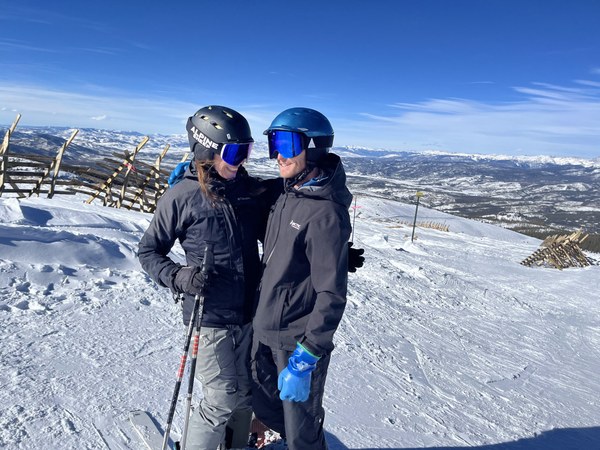 Erica and Ben at the top of the Panoramic Express chairlift in Winter Park.
Erica and Ben at the top of the Panoramic Express chairlift in Winter Park.
Recommended Gear for Beginners
In the hopes this benefits other beginner skiers, I put together a list of gear Ben and I procured. Gear is expensive; even though we bought a lot of used clothes and equipment at a discount, it took us about a year and a half to accumulate all of it. In the meantime, I borrowed stuff from Ben, his family members, and our friends.
- Note: Black Diamond replaced these with the Helio Carbon 95
- 173cm long, 123-95-113mm (tip-waist-tail widths).
- Ski length depends on height, weight, skiing style, and ability. According to Evo, a beginner skier of my height (5’6”) should have skis 155cm long, an intermediate skier 165cm long, and an expert 173cm long. Ben dressed me for the skier I wanted to be, not the skier I was!
- Wide skis have more surface area and provide more flotation in powder, but they’re harder to control and take more effort to turn. Narrow skis are easier to handle and require less effort to turn, but they sink under the snow in powder. The most important width measurement is waist width, the width of the ski under your foot. 95mm is mid-range, so I got skis that handle most conditions reasonably well.
- Tip rocker: 321mm, Sidecut radius: 19m, Tail rocker: 232mm.
- Rocker refers to the curvature of skis when viewed from the side. These skis have an upward bend in the tip and tail, which helps them pivot more easily and float in powder.
- Sidecut radius indicates how easily skis turn. The shorter the radius, the easier it is to turn. At 19m, these skis are designed for a wide range of snow conditions.
- Weight: 3,100 grams for the pair.
- Lighter skis are easier to move and carry, while heavier skis handle better in chopped-up snow. At 1,550g each, these are mid-weight touring skis.
- $700 new from Black Diamond, but we bought them plus the bindings and skins (below) from someone on Facebook for $650 total.
Salomon S/Lab Shift MNC 13 Bindings
- Hybrid resort / backcountry ski bindings: transition between ski mode and walk mode. When walking uphill, two pins go into either side of the boot toe, and I can lift my heel. When skiing downhill, the boot toe and heel are locked into the bindings.
- Multi-Norm Certified (MNC): fit a variety of ski boots and sole types.
- DIN range: 6 to 13.
- DIN refers to the scale of release force settings. The higher the DIN, the less likely the skis are to pop off. I set them at 7 so my boots release safely when I fall.
- Weight: 1,770 grams for the pair.
- Heavy for touring but light for resort bindings.
- $600 new from Salomon.
- Adhesive on one side, so they stick to the bottom of the skis, and nylon plush on the other side, which makes contact with the snow.
- Two hooks go around the tips of the skis and a clamp goes around the tails.
- Allow skis to slide forward but not backward when hiking uphill, must peel them off to ski downhill.
- $100 new from G3.
- Men’s boots, but the 24.5cm fit me like a charm.
- Last: 99mm.
- Last width numbers are stand ins for narrow, medium, and wide. Narrows range from 96 to 98mm, mediums from 99 to 101mm, wides from 102mm up.
- Flex rating: 120.
- The higher the flex rating, the stiffer the boot. The lower the flex rating, the softer the boot. Stiff boots provide better energy transfer from leg to ski and more control. Softer boots are more comfortable to wear.
- Flex ratings range from 60 to 140. These boots are at the higher end, recommended for accomplished skiers. Another example of getting gear with great expectations for my future abilities!
- Self Adjusting System: the back of the boot has a tab to pull up for hike mode and down for ski mode.
- Custom Adaptive Shape (C.A.S.) shell and liner: supposedly match the shape of the foot to provide the best out-of-the-box fit. Keep my feet warm.
- Four buckles and one Velco strap.
- Weight: 1,750 grams. Average weight for a resort boot that can tour.
- $700 new, but we bought these for $250 on Craigslist.
Rab Women’s Microlight Alpine Down Jacket
- Warm hip-length down jacket that I wear doing outdoor sports and around L.A.
- 2 zippered hand pockets, 1 zippered chest pocket, hood that I can tighten and loosen.
- $300 new
Black Diamond Women’s Highline Stretch Shell
- Water-repellant and very lightweight.
- 2 zippered hand pockets, 1 zippered chest pocket, pit zips for ventilation.
- Adjustable hood and cuffs at the wrists.
- $180 new.
Backcountry Women’s Last Chair Stretch Shell Pants
- Polyester snow pants that make me feel like a marshmallow but keep me warm.
- Two zip side pockets, two zips on inner thighs for ventilation, zip fly with two snaps.
- Bottom of pant legs have a snap and Velcro up the leg so I can make them bigger when fitting them over boots.
- $150 new.
- Ben discovered these on a backcountry snowboarding trip in Japan. Japanese fishermen use these gloves when working in cold water.
- Very waterproof and allow for dexterity, but don’t keep my hands warm. I wear a pair of liner gloves underneath.
- $25 new.
Smith Mirage Mips Women’s Helmet
- MIPS (Multi-directional Impact Protection System) technology reduces rotational forces from impact for increased safety.
- Strap that goes under my chin is easy to loosen and tighten. Clip in the back to hold goggles.
- Dial-fit system at the back of the helmet makes it easy to adjust the fit.
- Super soft where it makes contact with my head and ears, keeping them warm.
- $140 new.
- Protect my eyes from the glare of sun reflecting on snow, flexible frame, anti-fog lenses.
- $80 new for goggles and two magnetic lenses.
 Erica Broer
Erica Broer